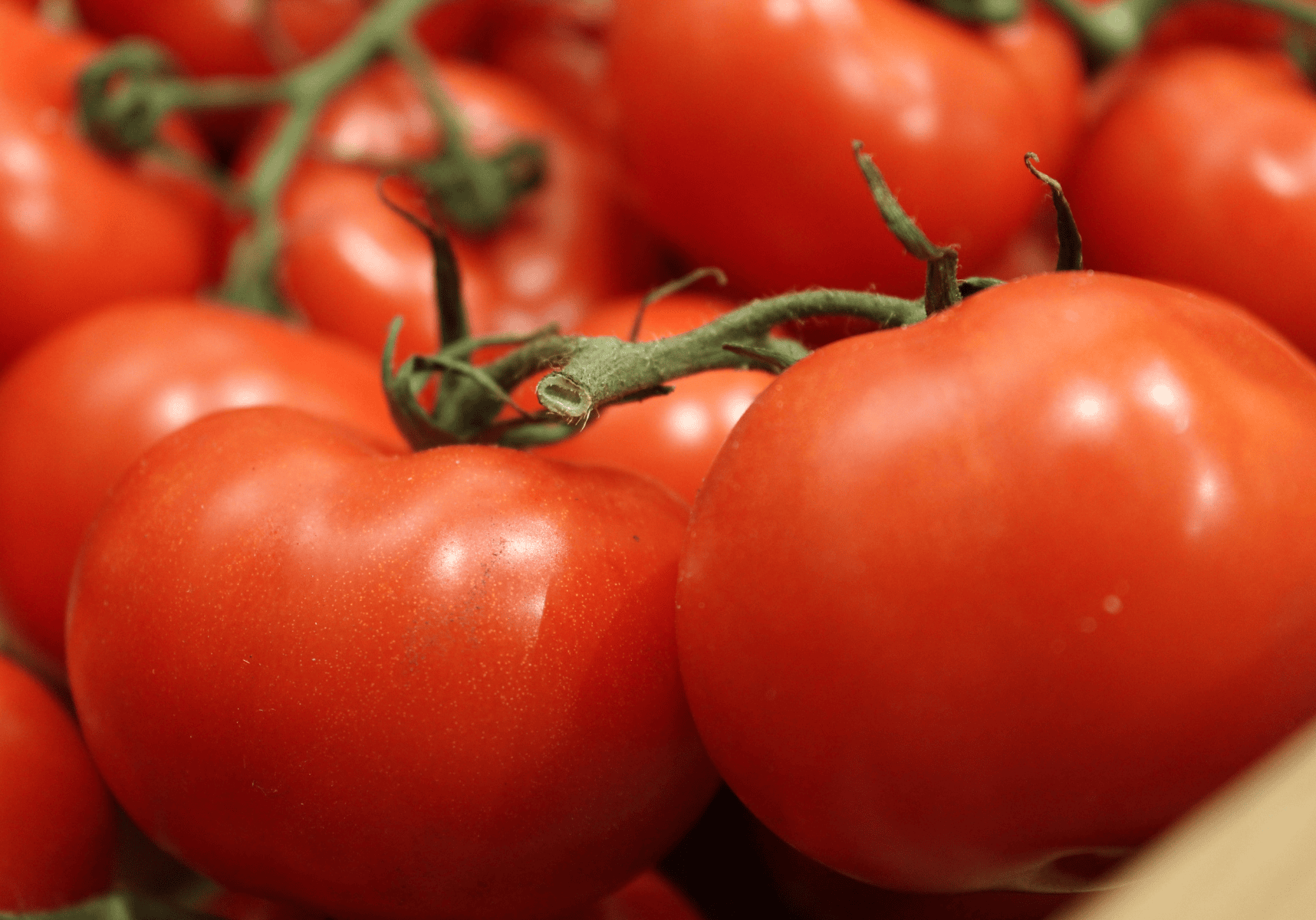
Ayurveda Hates Tomatoes … or Does It?
The Ayurvedic Perspective on Tomatoes - By Kate Siraj
Reading time: 5 minutes
Ayurveda says ‘no tomatoes’, right?
Well, it doesn’t actually.
Here are the facts.
There is nothing written about tomatoes in Ayurvedic literature
Tomatoes, solanum lycopersicum, came to India with the Portuguese several hundred years ago but Indians didn’t really use them in cooking until the 20th century. Therefore, tomatoes weren’t being used in India at the times when our ancient Ayurvedic texts were written. We don’t have any textual references for them.
Here is what we can assume given the qualities of tomatoes
By eating a tomato, we can tell that the taste is predominantly sour, with some sweetness. Sour tasting foods most often have a heating effect on the body, so we can assume that too.
The sour taste stimulates appetite and digestive fire, moistens, satiates, encourages elimination and is good for the heart. Sour foods are aggravating for pitta dosha (the fire and water components of us) and kapha dosha (the earth and water elements).
This is particularly so for pitta dosha for which it is the most aggravating taste. Vata dosha (our air and space elements) is pacified by the sour taste. The sourness comes from organic acids in the foods and in excess, can cause burning. Excess sour taste also leads to thirst, flabbiness, weakness, defective vision, ulcers, itching, pallor and skin diseases[1].
Cooking food in Ayurveda makes it easier to digest and often makes it sweeter. So, we can assume that cooked tomatoes are potentially easier to digest and slightly sweeter, less sour. Other processes that increase sweetness and decrease sour are drying (sundried) and ripening (vine-ripened and seasonally grown).
Tomatoes belong to the Solanaceae or nightshade family of plants. Whilst there is no mention of the fellow nightshades potatoes or peppers in the ancient texts (they were all later imports), there is mention of aubergines which are a member of the family.
There are also several medicinal herbs which belong to this family which are detailed in the texts. Fully-grown aubergine (solanum melongena, vrntaka, brinjal) is described as being sweet, hot in potency, penetrating, has a pungent effect post-digestion, increases pitta and decreases vata and kapha.
It is hard to digest, especially if cooked with oil.[2] The other 3 solanaceae detailed in the texts are also heating, with a pungent post-digestive effect, increase pitta and decrease vata and kapha.
Whilst different members of a family can have different qualities, it could be a fair assumption that tomatoes could also be heating, possibly having a pungent post-digestive effect and most likely increase pitta and decrease vata.
It is safe to assume, therefore, that tomatoes will increase pitta and probably kapha, whilst decreasing vata. Excess of them, with their sour and heating nature, could lead to burning (for example, in the digestive tract) and skin diseases.
Modern insights
The tomato has become a staple of many diets around the world and there is a wealth of research into their benefits. They have a rich vitamin and mineral content as well as strong antioxidant properties (most noticeably from lycopene) and have been proven to be useful in prostate cancer prevention[3].
What’s not to like then?
Tomatoes contain toxic tomatine
There hasn’t been a great deal of research into the downsides of tomatoes. We do know, however, that nightshades, including tomatoes, contain toxic compounds called glycoalkaloids which help the plants resist microbes, fungi and animals. The main glycoalkaloid in tomatoes is tomatine whereas for the potato it is solanine, which is more toxic than tomatine.
These glycoalkaloids can disrupt cellular membranes and kill cells (such as in the digestive tract), cause neurological dysfunction through inhibiting the enzyme acetylcholinesterase and cause gastrointestinal disturbances in high doses. The clearance of glycoalkaloids from the body usually takes more than 24 hours, so these toxins may accumulate on daily consumption.[4]
Theoretically therefore, tomatine can cause inflammation, worsening conditions such as gastrointestinal problems (IBS – irritable bowel syndrome, IBD – inflammatory bowel disease), rheumatoid arthritis and other autoimmune conditions and neurological conditions (Parkinson’s, MS – multiple sclerosis).
This is especially likely in sensitive individuals but there is very little evidence to show the health impacts of long-term exposure to low levels of glycoalkaloids. One piece of research has shown that glycoalkaloids can cause digestive dysfunction.[5]
Tomatoes are high in anti-nutrient lectins
Tomatoes, and other nightshades, are also high in the anti-nutrient lectins, which can reduce absorption of other nutrients, and which have been shown to inflame the gut and lead to autoimmune responses in rats (but there is no research backing this in humans).
Some people report improvements in arthritis symptoms when tomatoes they avoid tomatoes but some others see no noticeable effect.
So, what does this all mean? Should I eat tomatoes or not?
If you have certain conditions, cut out tomatoes entirely
If you have IBS, IBD, burning sensations in the digestive tract, skin diseases, autoimmune diseases and any joint inflammation, you may want to avoid tomatoes entirely for two months and watch to see if your symptoms improve. Even if you have only a slight improvement, it would be good to continue avoiding tomatoes or have them in very small quantities, ripe, peeled and cooked.
If you have high pitta or kapha, have very little tomatoes
If you have high pitta (e.g. burning sensations, loose bowel movements, bleeding, ulcers, excessive thirst, anger etc.) or kapha (excess mucous, weight gain, water retention, excess urine, heaviness, lack of appetite, nausea, lethargy etc.) then have tomatoes only sparingly. This could be 1-2 per week and always ripe, peeled and cooked.
Otherwise, eat in moderation
In Ayurveda, there are a selection of pathya foods that are said to be good to eat daily. These include rice, wheat (ancient types), barley, mung beans, grapes, pomegranates, ginger, ghee, unhomogenised milk, buttermilk and honey. Other foods shouldn’t be eaten every day and the amounts of them will vary depending on your constitution and imbalance with variety and moderation being the key. For tomatoes, 3-4 per week should be fine which includes tomatoes in sauces.
Always eat tomatoes cooked
Tomatine and lectins can break down with cooking. This is often not complete but does reduce the quantity of these toxins. Ayurveda suggests cooking fruit and vegetables as it makes them easier to digest and tomatoes are an even more important example of this.
Eat your tomatoes ripe
The riper the fruit, the less predominant the sour taste and the greater the sweet taste. This makes ripe tomatoes less pitta aggravating. Tomatine is present in unripe fruit to a much greater extent than ripe fruit so riper means less of the potentially toxic tomatine in your tomatoes.
Remove the skins
As toxic tomatine has a higher concentration in the skins of tomatoes, removing the skin will help reduce any unwanted side effects of the tomatoes.
If in doubt about whether tomatoes are the right foods for you, seek the help of a fully qualified Ayurvedic Practitioner or do a course in Ayurveda to discover the current state of your dosha.
[1] Astanga Hrdaya Sutra Sthana 10/10-11, Astanga Samgraha Sutra Sthana 18/8-9
[2] Bhavaprakasha of Bhavamishra Vol 1 Cp 6 Guduchyadi varga
[3] Ali MY et al. Nutritional Composition and Bioactive Compounds in Tomatoes and Their Impact on Human Health and Disease: A Review. Foods. 2020 Dec 26;10(1):45. doi: 10.3390/foods10010045. PMID: 33375293; PMCID: PMC7823427.
[4] Mensinga TT et al. Potato glycoalkaloids and adverse effects in humans: an ascending dose study. Regul Toxicol Pharmacol. 2005 Feb;41(1):66-72. doi: 10.1016/j.yrtph.2004.09.004. Epub 2004 Dec 10. PMID: 15649828.
[5] Kuang R et al. Nightshade Vegetables: A Dietary Trigger for Worsening Inflammatory Bowel Disease and Irritable Bowel Syndrome? Dig Dis Sci. 2023 Jul;68(7):2853-2860. doi: 10.1007/s10620-023-07955-9. Epub 2023 May 19. PMID: 37202602.







